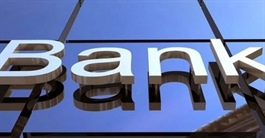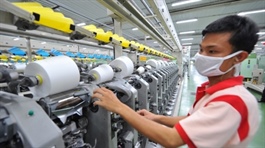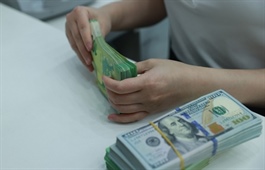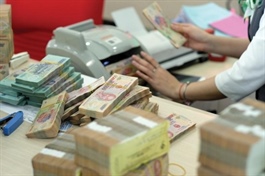Exchange rate offering test for economic footing
Exchange rate offering test for economic footing
As VND weakens to a record low against the USD, Vietnam faces a critical test in balancing growth-supportive policies with currency stability in the last six months amid tightening external conditions.
On July 10, the State Bank of Vietnam (SBV) announced a historic central exchange rate of VND25,131 per USD, up VND12 from the previous day and VND10 higher than the key benchmark set on July 8.
The increase followed US President Donald Trump’s escalation of the global trade war with threats to impose a 50 per cent tariff on copper.
While aggressive tariff policies have stirred uncertainty, the market appears to be adjusting to the US’ deadline tactic in negotiations, such as the August 1 date proposed for new tariffs, which has helped reduce initial market shock.
Despite a few sessions of mild correction, the exchange rate has continued to rise steadily since early July and remains under significant pressure. According to the SBV, as of the end of June, the VND had depreciated by about 2.8 per cent against the USD.
With a 5 per cent trading band, commercial banks are currently allowed to quote the US exchange rate between VND23,874-26,388. Meanwhile, the SBV’s reference buying and selling rates have been raised to VND23,926 and VND26,336 per USD, respectively.
Nguyen The Minh, head of Research and Development for Retail Clients at Yuanta Securities Vietnam, commented that the exchange rate is likely to remain under short-term pressure until more clarity emerges on global tariff measures.
“Last week, although President Trump mentioned reciprocal tariffs, no further details have been released. That said, the market had largely anticipated this, and while the DXY index has continued to fall, the domestic exchange rate has surged. This reflects risk aversion and market uncertainty about whether Vietnam’s tariff competitiveness still holds up against other countries,” said Minh.
“Currently, CME Group data shows a high probability of one or two US Federal Reserve rate cuts this year, likely in September or October. That may be the point when exchange rate pressure in Vietnam begins to ease,” said Minh.
Finance expert Dr. Nguyen Tri Hieu predicted that the exchange rate could rise by at least 5 per cent this year. “The current phenomenon of the exchange rate increasing despite a weakening USD is primarily due to our relatively thin foreign exchange reserves, which currently stand at around $80 billion,” he noted. “Meanwhile, the average value of three months of imports in the first half of the year was $105 billion. This means our reserves fall short of the international benchmark of covering three months of imports, which is a crucial standard for ensuring liquidity in the economy.”
Commenting on the impact of sustained rate increases on the economy, Hieu warned that a rising exchange rate would fuel inflation.
“Our economy is heavily reliant on exports and imports. When the exchange rate rises, the VND-denominated prices of all imported goods increase accordingly, thereby pushing up overall inflation,” he said. “A rising exchange rate also affects other markets, such as driving gold prices higher and contributing to inflationary sentiment. Overall, macroeconomic balances will be significantly impacted by continued exchange rate increases, not only through inflation and foreign exchange reserves, but also via spillover effects on other key economic indicators.”
In a report published on July 8, UOB experts asserted that with overall and core inflation staying below the official target of 4.5 per cent in first half and for most of 2024, this opens the possibility for the SBV to ease its policy stance. However, the foreign exchange market is likely another key consideration for the central bank.
“The VND was the worst performing Asian currency in the first half of 2025, declining by 2.5 per cent against the USD. However, the strong performance of the overall economy may have eased pressures for policy easing. As such, we expect the SBV to keep its main policy rate steady for now, with the refinancing rate held at 4.5 per cent,” UOB stated in the report.
“We expect the currency to remain near the weaker end of its trading band against the USD through Q3. However, by Q4, the VND may begin to align with the broader recovery in Asian currencies as trade uncertainties ease. Our updated USD/VND projections are 26,400 in Q3, 26,200 in Q4, 26,000 and 25,800 in Q1 and Q2 2026 respectively,” forecasted UOB.
Pham Chi Quang, director general of the SBV’s Monetary Policy Department, stated at a July 8 press briefing that one of the primary reasons is the widening interest rate differential between the VND and USD. This has occurred as domestic interest rates have been significantly lowered to support economic growth.
“To maintain the strength of a currency, its appeal must be preserved, and interest rates are a key factor, as they directly reflect a currency’s value,” he said. “Maintaining low VND interest rates while USD interest rates remain high globally has resulted in a negative interest rate spread between them. In such a context, market liquidity tends to shift towards the USD, given its higher yields, thus exerting pressure on the USD/VND exchange rate.”
- 11:18 16/07/2025


























